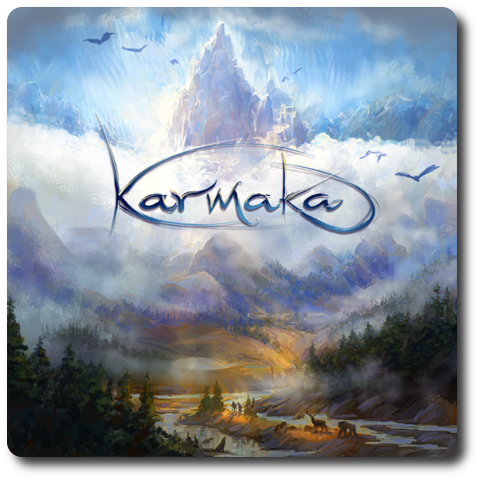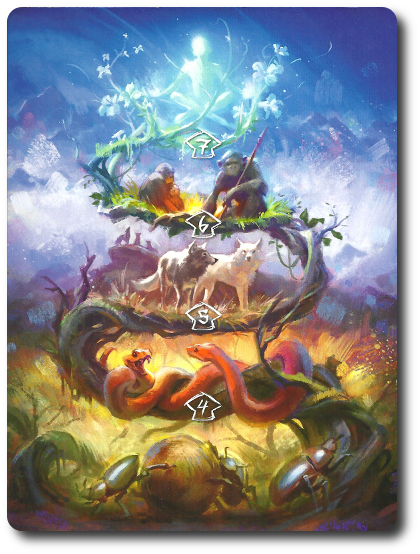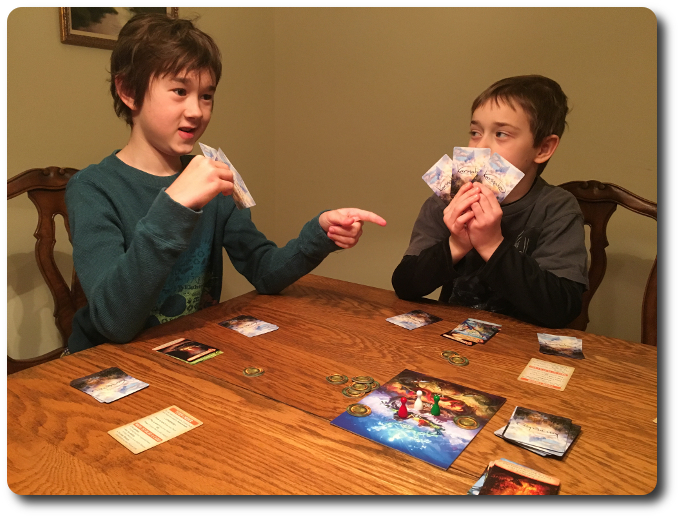Please Take Note: This is a review of the final game, but it might change slightly based on the success of the Kickstarter campaign. The game is being reviewed on the components and the rules provided with the understanding that “what you see is not what you might get” when the game is published. If you like what you read and want to learn more, we encourage you to visit the game publisher’s website or visit the Kickstarter campaign. Now that we have all that disclaimer junk out of the way, on with the review.

The Basics:
- For ages 8 and up (publisher suggests 10+)
- For 2 to 4 players
- Approximately 45 minutes to complete
Geek Skills:
- Active Listening & Communication
- Counting & Math
- Logical & Critical Decision Making
- Reading
- Pattern/Color Matching
- Strategy & Tactics
- Hand/Resource Management
Learning Curve:
- Child – Easy
- Adult – Easy
Theme & Narrative:
- The road to enlightenment begins with a single step
Endorsements:
- Gamer Geek mixed!
- Parent Geek mixed!
- Child Geek approved!
Overview
American author and self-proclaimed psychic medium, Sylvia Browne, said “Reincarnation occurs because we decide that we haven’t learned enough lessons.” Suggesting that life is a classroom in which we learn and are tested. Success and failure result not in grades, but karma that is stacked and measured. What we do in this life ripples into the next as we make our way to a transcendent state. Which, in my opinion, will feel an awful lot like waking up in a really cozy bed for all of eternity.
Karmaka, designed by Eddy Boxerman, Dave Burke, and to be published by Hemisphere Games, will reportedly be comprised of 19 Red cards, 19 Green cards, 19 Blue cards, 7 Mosaic cards, 12 Karmic Ring tokens, 1 Karmic Ladder game board, 4 Reference cards, and 4 Player tokens. As this is a review of a prepublished game, I cannot comment on the game component quality. Proposed art by illustrators Lane Brown and Marco Bucci are beautiful and vibrant with color.
On the Road to Enlightenment
To set up the game, first place the Karmic Ladder game board in the middle of the playing area and have each player select a Player token of their choice. Place the Player tokens on the “Dung Beetle” image (located at the bottom of the game board). Any Player tokens not used should be returned to the game box.

Second, remove the Reference cards and give 1 to each player. Then shuffle the rest of the cards and deal 4 cards face-down to each player. This is the player’s starting hand. Players should pick up their hand now and look at their cards, but keep them hidden from their opponents. Then deal 2 cards to each player, keeping them face-down. Players should take these cards and put them in a stack to their left. This is the player’s draw deck and the cards should not be looked at. The rest of the cards are placed face-down next to the Karmic Ladder game board. This is the Well for the duration of the game.
Third, place the Karmic Ring tokens in a pool next to the Karmic Ladder game board. This is the Karmic Ring pool for the duration of the game.
That’s it for game set up. Determine who should go first and begin.
Many Lives, Many Lessons
Karmaka is played in turns with no set number of turns per game. A player’s turn is summarized here.
Step 1: Draw One Card
If the player is able to (meaning there are cards available), they draw the top-most card from their draw deck (not the Well). This card is added to their hand of cards and can be played this turn.
Step 2: Play One Card
If the player drew a card from their hand this turn, they may skip this step and end their turn. If they decide to play a card, they can play 1 card from their hand 3 possible ways.
Play Card for Points (Deeds)
Every card has a number value and color. Players earn points that are changed to Karmic Rings by playing cards to their Deed pile. Cards played here are left face-up and organized so their number value and color are showing. The Deed pile should be just right of the player’s draw deck.
Play Card for Future Use
If the player likes the card, but does not want to lose it or play it, they can stash it away for later. This is done by placing the card in the player’s Future Life deck, which should be located right of the Deeds pile. Cards placed in the Future Life deck are always left face-down. Cards in a player’s Future Life deck will change to the player’s draw deck later in the game.
Play Card for Ability
A card can be played for its listed ability. The player announces they are playing the card, reads the ability out loud, and then resolves it if possible (cards can always be played even if they don’t have any effect). The player must then offer it to the opponent immediately to their left or to the opponent they targeted. If the player’s opponent takes it, the card is placed in the opponent’s Future Life deck. If it’s not, the card is placed face-up in a discard pile referred to as the “Ruins” next to the Well.
This completes the player’s turn and their opponent now takes their turn.
Birth, Life, Death, Birth
Players continue taking their turns and 2 steps. If a player begins their turn with an empty hand and is unable to draw anymore cards, they have “died”. But death is not the end in this game. The player is reborn and possibly advances. This cycle of death and rebirth will take place many times in the game and to different players.
Score Karma
The first thing a player does when they “die” is determine how well they did during their life. This is done by counting points earned in the player’s Deeds pile. Only 1 card color can be scored per death, but the player gets to choose which color that should be. Usually it’s the color that has the most points. Points are determined by adding up the number values of all the cards of a single color. Mosaic cards are considered “Wild” and can be any color the player chooses. Once counted, the player takes 1 Karmic Ring token per point earned.
For example, the following 4 cards are in the player’s Deeds pile. The highest valued card is the green “3”. The player also has a Mosaic card that represents any color. The player has earned a total of “4” Karmic Ring tokens.
Rebirth and Transcendence
The Karmic Ladder game board displays arrows with a number value within them. This number value identifies how much Karma a player needs to pay to move to the next stage in their transcendent journey. The player pays using their Karmic Rings. If they have enough to advance, they return the Karmic Rings back to the pool and move their Player token up to the next stage. If they cannot, they keep the Karmic Rings and should work to earn more.
A player then moves all the cards in their Deeds pile to the Ruins. When they begin a new life, their slate of deeds is wiped clean. Then the player takes their Future Life cards and uses them as their new hand of cards. If the player’s hand of cards contains 5 or fewer cards, draw any number of cards from the Well to create a new draw deck so the total number of cards in the player’s draw deck and hand is 6 cards.
The player is now in a state of Limbo until their next turn. They cannot play any cards or take any actions. During this time, opponents cannot be blocked or hampered, either. This leaves the player temporarily vulnerable, unable to take any offensive or defensive actions. But players should remember: what goes around, comes around.
Enlightenment and Victory
The first player to reach the very top of the Karmic Ladder game board wins the game, most likely bragging even though they are “Enlightened”.
To learn more about Karmaka, visit the game publisher’s website or visit the Kickstarter campaign.
Final Word
The Child Geeks learned how to play the game quickly and started to get into the swing of things. The most difficult aspect of the game for them was thinking long-term and stashing cards away for their Future Life. They tended to focused on their Deeds pile and collecting points. Which is not a bad thing at all and is a legit strategy. However, focusing only on Deeds means the player is leaving their next hand of cards up to luck and randomness. According to one Child Geek, “I’d rather earn points now that I know I can use and take my chances earning fewer points later.” Understand that this is the same crowd that will more times than not take 1 cookie now rather than 2 cookies later. This mentality was present throughout most of the game and also reflected the Child Geek’s competitive nature. A few of the Child Geeks tried to balance their short and long-term goal, but all the Child Geeks agreed it felt better to earn points. When all the games were over, the Child Geeks were rather reflective about their gaming experience. About half felt the game was simple “OK”, while the other half found Karmaka to be entertaining enough to be played again. The end result was a mostly positive endorsement from the Child Geeks.

My oldest son reminds his opponent that Karma can be “unpleasant”
The Parent Geeks had no problems with the game and demonstrated excellent strategic game play by saving cards for later and taking advantage of using cards for their actions. According to one Parent Geek, “I like how the cards can be used for actions, but are then taken by an opponent. This means they could use it later on you. Makes you stop and think who you will use it on.” Another Parent Geek said, “I like some of what this game is doing, but it starts to feel repetitive after a bit. The only thing that changes is the cards you have and the actions that are played on you.” The first game was always well received, but subsequent games became less and less energetic. According to one Parent Geek, “I think this game would be great maybe once a week or no more than 2 times a month.” When the votes came in, the Parent Geeks were mixed regarding their feelings. While they appreciated many aspects of the game, they also found it difficult to say they enjoyed it enough to want to play it again. About half didn’t hesitate to check the “recommend” box, while the other half responded with uncertainty.
The Gamer Geeks were similar to the Parent Geeks. They felt the game was doing a lot of things right, but not necessarily the best. According to one Gamer Geek, “The game is well thought out, plays casual with the need to think about your actions, and does feel challenging enough to keep you locked in the game. What I don’t like is that it’s always the same thing over and over again.” Which is to say, this particular Gamer Geek felt that the road to enlightenment was rather flat and only had the occasional bump in it due to opponent actions. Another Gamer Geek said, “I don’t see why any player couldn’t score points every round, which leads me to believe this is a game that is trying to be everything to everyone. Games like that always feel bland to me.” Karmaka does allow players to score points fairly easily, but it also allows players to mess with each other. In short, the game gives the player the choice. Finally, one last Gamer Geek said, “A good game for casual players, but I wouldn’t play the game very often. I don’t know why anyone would ever not just focus on points unless they are a jerk and just want to focus on messing up other players, losing the game in the process.” The final vote from the Gamer Geeks was also mixed. The Gamer Geeks never felt that Karmaka was a poorly designed game, but they did strongly feel that it wasn’t a game that would necessarily always be welcome at the elitist’s gaming table.
I have always enjoyed games like Karmaka because they play light, are easy to teach, and yet still challenge a player to think about their actions. Games like this are always easy to get to the table and play well with a mixed crowd. Karmaka doesn’t feel dumbed down and can be enjoyed by more serious gamers, and yet is not so complex as to leave the non-gamers shut out in the cold.
But the game’s greatest perks are also its heaviest flaws. Karmaka felt like “milquetoast” to a number of our players in 2 out of our 3 groups. Which is to say, the players didn’t feel like the game was trying to engage them or was competitive enough out of fear of alienating players. With the understanding that such assertions are subjective opinions, we can easily dismiss any negative comments and focus purely on the positive, but that is not what reviews are all about. The wider we cast our net, the more comments we pull in, giving us a clearer picture of what it is we are looking at.
What we have here is a casual game with some complex ideas. It challenges players to make choices that have consequences, but the consequences themselves are never so sever as to make the player pause and shudder at what “might be”. The game moves swiftly with well-defined actions and interesting player interaction, but a sense of “sameness” starts to settle in as the players continue to add cards to one pile and take from another. Strategic foresight is necessary, but only in the sense that it compliments reactionary hindsight.
The end result is a game that neither felt spectacular or disappointing. Karmaka provided many remarkable moments and forgettable ones, as well. The consistent mixed reviews from our players were more positive than negative, but always seemed to settle firmly on the fence. Wherein the player could take or leave the game.
What does this mean to you? Really nothing until you’ve played the game yourself. It does suggest that Karmaka is a game that will be enjoyed by just about everyone and can be played more times than not as a result. The game’s theme is a bit difficult for children to understand, but plays no real part in the game play itself other than to provide thematic background and an arcing narrative throughout. If you enjoy quick to learn card games and having to make choices each and every turn that focus on immediate benefits or long-term goals, then do try Karmaka. It might not enlighten you, but I’m sure it will brighten your day.
This is a paid for review of the game’s final prototype. Although our time and focus was financially compensated, our words are our own. We’d need at least 10 million dollars before we started saying what other people wanted. Such is the statuesque and legendary integrity of Father Geek which cannot be bought except by those who own their own private islands and small countries.



